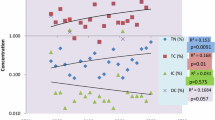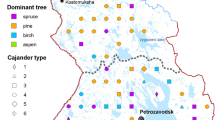Abstract
This article addresses spatial variability in soil nutrients in altitudinal and latitudinal forest–tundra ecotones in the Kola Peninsula, Russia. Higher total carbon, nitrogen, and bio-available nutrients were found in the organic horizons of latitudinal ecotone against the background of lower nutrients in soil-forming rock. This is supposedly related to higher contribution of nutrient-rich plants in latitudinal ecotone and intense downward within-profile matter migration in the altitudinal ecotone. Elevated bio-available soil nutrients in spruce forests compared with birch forests and tundra sites, and in birch forests compared with tundra against the background of different trends in the soil-forming rock were attributed to the effects of predominant plants. The effects of predominant plants on soil nutrients were distinctly pronounced at the level of site patches. Soil-forming rock effects on soil nutrients were clear at the level of zones/belts and the whole ecotones. Strong negative correlations between the soil nutrients and altitudes were explained by replacement of vascular plants by low-ash lichens at higher elevations.












Similar content being viewed by others
References
ACIA (2005) Arctic climate impact assessment. Cambridge University Press, Cambridge
Angers DA, Caron J (1998) Plant-induced changes in soil structure: processes and feedbacks. Biogeochemistry 42:55–72
Berense F (1998) Effects of dominant plant species on soils during succession in nutrient-poor ecosystems. Biogeochemistry 42:73–88
Berg B (2000) Litter decomposition and organic matter turnover in northern forest soil. For Ecol Manage 133:13–22
Berkvist B, Folkeson L (1995) The influence of tree species on acid deposition, proton budgets and element fluxes in south Sweden forest ecosystems. Ecol Bull 44:90–99
Binkley D, Giardina Ch (1998) Why do trees affect soils? The warp and woof of tree–soil interactions. Biogeochemistry 42:89–106
Bormann FH, Likens GE (1979) Pattern and process in a forested ecosystem. Springer, New York
Christiansen JR, Vesterdal L, Callesen I, Feberling B, Schmidt IK, Gundersen P (2010) Role of six European tree species and land—use legacy for nitrogen and water budgets in forests. Glob Chang Biol 16(8):2224–2240. doi:10.1111/j1365-2486.2009.02076.x
Cornelissen JHC, Thompson K (1997) Functional leaf attributes predict litter decomposition rate in herbaceous plants. New Phytol 135:109–114
Cornelissen JHC, Lang SI, Soudzilovskaia NA, During, HS (2007a) Comparative cryptogam. A review of bryophyte and lichen traits that drive biogeochemistry. Ann Bot. doi:10.1093/aob/mcm030. Available online www.aob.oxfordjournals.org/misc/terms.shtml
Cornelissen JHC, Van Bodegom PM, Aerts R, Callaghan TV, van Logtestijn RSP, Alatalo J, Chapin FS, Gerdo R, Gudmundsson J, Gwynn-Jones D, Hartley AE, Hik DS, Hofgaard A, Jonsdottir IS, Karlsson S, Klein JA, Laundre J, Magnusson B, Michelsen A, Molau U, Onipchenko VG, Quested HV, Sandvik SM, Schmidt IK, Shaver GR, Bjorn Solheim B, Nadejda A, Soudzilovskaia NA, Anna Stenstro F, Tolvanen F, Totland O, Wada N, Welker JM, Zhao X, Team MOL (2007b) Global negative vegetation feedback to climate warming responses of leaf decomposition rates in cold biomes. Ecol Lett 10:619–627. doi:10.1111/j.1461-0248.2007.01051.x
Danby RK, Hik DS (2007) Variability, contingency and rapid change in recent subarctic alpine tree line dynamics. J Ecol 95:352–363
Dokuchaev VV (1936) Russian chernozem. 558 (in Russian)
Gorbacheva TT, Lukina NV (2006) Dynamics of plyphenol contents in the course of litter fall and litter decomposition in spruce forests with green mosses on the Kola Peninsula. Russ For Sci 3:10–24
Halonen O, Tulkki H, Derome J (1983) Nutrient analysis methods. Metsantutkimuslaitoksen tiedonantoja 121:1–28
Hobbie SE (1992) Effects of plant species on nutrient cycling. Trends Ecol Evol 7:336–339
ISO 11272 (1993) Soil quality—determination of dry bulk density. International Organization for Standardization, Geneva, p 10
IUSS Working Group WRB (2006) World reference base for soil resources 2006. World Soil Resour Rep No 103. FAO, Rome
Jackson RB, Banner JL, Jobba’gy EG, Pockman WT, Wall DH (2002) Ecosystem carbon loss with woody plant invasion of grasslands. Nature 418:623–626
Jenny H (1958) Role of the plant factor in the pedogenic functions. Ecology 39(1):5–16
Jones CG, Lawton JH, Shachak M (1994) Organisms as ecosystem engineers. Oikos 69:373–386
Kammer A, Hagedorn F, Shevchenko I, Leifeld J, Guggenberger G, Goryacheva T, Rigling A, Moiseev P (2009) Treeline shifts in the Ural Mountains affect soil organic matter dynamics. Glob Chang Biol. doi:10.1111/j.1365-2486.2009.01856
Karpachevsky LO (1977) Mosaic of soil cover in forest biogeocenosis. Moscow, Edition of Moscow State University, 312 p
Kullman L (2002) Rapid recent range-margin rise of tree and shrub species in the Swedish Scandes. J Ecol 90:68–77
Lindeberg G (1944) Ueber die Physiologie Ligninabbauender Boden hymenomyzeten. Symb Bot Upsal VIII(2):183
Lloyd AH (2005) Ecological histories from Alaskan tree line provide insight into future change. Ecology 89:1687–1695
Lovett G (1992) Atmospheric deposition and canopy interactions of nitrogen. In: Johnson D, Lindberg S (eds) Atmospheric deposition and forest nutrient cycling. Springer, New York, pp 152–165
Lukina NV (2008) Plant-induced variability in soil acidity and nutrient status of boreal forest ecosystems. In: John D, Antii-Jussi L, Tuire K (eds) Proceedings of scientific seminar on forest condition monitoring and ecosystem functioning in northern Europe under the forest focus and ICP forests programmes, Vantaa 27–28.11.2007. Finnish Forest Research Institute, Helsinki, Finland, pp 48–54. ISBN 978-951-40-2088-9
Lukina NV, Nikonov VV (1996) Biogeochemical cycles in the northern forests under air pollution. In 2 Vols. Apatity. Edition of the Kola Scientific Centre RAS. Volume 1–213 p, Volume 2–132 p
Lukina NV, Nikinov VV (1998) Nutritional status of the northern taiga forests: natural and pollution-induced regularities. Apatity. Edition of the Kola Scientific Centre RAS. 316 p
Lukina NV, Gorbacheva TT, Nikonov VV, Lukina MA (2003) Spatial variability of soil acidity in the course of human-induced (technogenic) succession of forest biogeocenoses. Eurasian Soil Sci 361(1):32–45
Manakov KN (1972) Productivity and biological cycles in tundra biogeocoenoses. Nauka, Leningrad, p 147
Manakov KN, Nikonov VV (1979) Main parameters of biological cycles in spruce forests on the Kola Peninsula. Pochvovedenie 8:60–69
Manual on methods and criteria for harmonized sampling, assessment, monitoring and analysis of the effects of air pollution on forests (2010) Part X. Sampling and analysis of soil. http://www.icp-forests.org/pdf/FINAL_soil.pdf
McGuire A, Hobbie J (1997) Global climate change and the equilibrium responses of carbon storage in arctic and subarctic regions. In: Modeling the arctic system: a workshop report of the arctic system science program. Arctic Research Consortium of the U.S., Fairbanks, pp 53–54
Moiseev PA, Shiyatov SG (2003) The use of old landscape photograph for studying vegetation dynamics at the tree line ecotone in the Ural highlands, Russia. In: Nagy L, Grabherr G, Körner C (eds) Alpine biodiversity in Europe (ecological studies 167). Springer, Berlin, pp 423–435
Myagkova A.S. (1988). Estestvenniye i antropogenniye izmeneniya Khibin za golocen [Natural and antropogenic changes in Khibiny mountains during the Holocene] (in Russian). PhD thesis, Faculty of Geography, Lomonosov Moscow State University, Moscow
Nihlgard B (1971) Pedological influence of spruce planted on former beech forest soils in Scania, South Sweden. Oikos 22:195–207
Nikonov VV, Lukina NV, Frontasyeva MV (2004) Plants. In Isaev AC (ed) Trace elements in boreal forests. pp 151–188
Onipchenko VG, Makarov MI, Eddy van der M (2001) Influence of alpine plants on soil nutrient concentrations in a monoculture experiment. Folia Geobot 36:225–241
Perez J, Jeffries TW (1992) Roles of manganese and organic acid chelators in regulating lignin degradation and synthesis of peroxidases by Phanerochate chrysosporium. Appl Environ Microbiol 58:2402–2409
Saleska SR, Shaw MR, Fischer ML, Dunne JA, Still CJ, Holman ML, Harte J (2002) Plant community composition mediates both large transient decline and predicted long-term recovery of soil carbon under climate warming. Glob Biochem Cycles 16. doi 10.1029/2001GB001573
Semenov AV (2008) Instrumental climatic observations on the Kola Peninsula, and providing the regional customers with climatic information. Report on International conference of adaptation to climate change and its role in sustainable development of regions. http://rusrec.ru/ru/news/1513
Shein EV (2005) Soil physics course. Moscow State University Press, Moscow, Russia, 432
StatSoft Inc. (2010) STATISTICA (data analysis software system), version 9.1. www.statsoft.com
Sturm M, McFaden JP, Liston GE, Chapin IFS, Holmgren J, Walker M (2001) Snow–shrub interactions in Arctic tundra: a hypothesis with climatic implications. J Clim 14:336–344
Van Breemen N, Finzi AC (1998) Plant–soil interactions: ecological aspects and evolutionary implications. Biogeochemistry 42:1–19
Vlasenko PV (Ed) (1988) Nauchno-prikladnoy spravochnik po klimatu SSSR [Science and applied guide to the climate of USSR]. Series 3: Multi-year data. Parts 1–6, Issue 2. Gidrometeoizdat, Murmansk Region, Leningrad, p 316 (in Russian)
Vorob’ova LA (1998) Khimicheskiy analiz pochv [Soil chemical analysis]. Moscow State University Press, Moscow, Russia, p 272 (in Russian)
Zyuzin Y., Demin V. (2007). Climate of the Khibiny Mountains. Extended abstract. In: Proceedings of the 29th international conference on alpine meteorology Chambéry, France, 4–8 June 2007 (Online)
Acknowledgments
The authors are grateful to the Research Council of Norway for financial support through grants to A. Hofgaard from the program OST, project 185023/S50; and program IPY, project 176065/S30. M. Orlova is also supported by Grant of President of the Russian Federation for Young Scientists (MK-4046.2011.4). N. Lukina is also supported by the project 10-04-00213a of the Russian Foundation for Basic Research and by the “Biological diversity” Programme for basic research of the Presidium of the Russian Academy of Sciences. O. Tutubalina has been supported by the Leading Science Schools programme of Russian Federation, grant No. HШ 3405.2010.5 and Russian Scientific Educational Centres program « HOЦ » , grant No. 14.740.11.0200. The authors also thank A. Mikheeva for help in preparing Fig. 1. The article is a product under the IPY core project PPS Arctic.
Author information
Authors and Affiliations
Corresponding author
Electronic supplementary material
Below is the link to the electronic supplementary material.
Rights and permissions
About this article
Cite this article
Orlova, M.A., Lukina, N.V., Tutubalina, O.V. et al. Soil nutrient’s spatial variability in forest–tundra ecotones on the Kola Peninsula, Russia. Biogeochemistry 113, 283–305 (2013). https://doi.org/10.1007/s10533-012-9756-6
Received:
Accepted:
Published:
Issue Date:
DOI: https://doi.org/10.1007/s10533-012-9756-6




